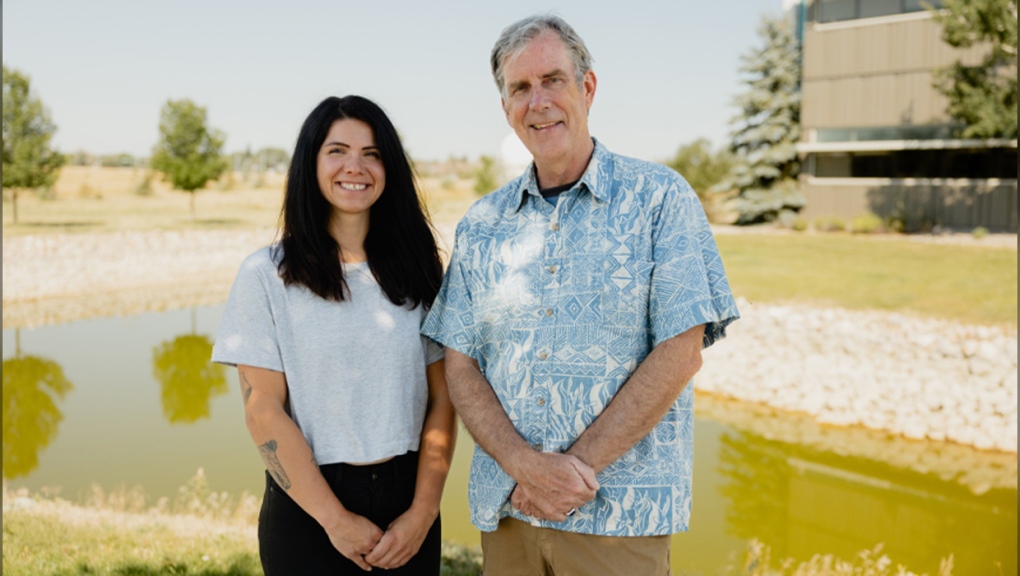Retired Lethbridge professor Joe Rasmussen has new species of aquatic parasite named after him
 Retired University of Lethbridge professor Joe Rasmussen recently had a new species of aquatic parasite named after him. (Photo: University of Lethbridge)
Retired University of Lethbridge professor Joe Rasmussen recently had a new species of aquatic parasite named after him. (Photo: University of Lethbridge)
A retired University of Lethbridge professor is being recognized by having a newly-discovered aquatic parasite named after him.
The unique scientific honour came about after a U of L undergraduate, Molly Tilley, discovered large, white lesions surrounding the eyes of the fathead minnows in the university’s pond.
That led to what Tilley and supervisor Dr. Cam Goater describe as an “emerging parasite” capable of disrupting the aquatic food chain – which, given its discovery in the waters of southern Alberta, the duo named Myxobolus rasmusseni as a tribute to retired U of L aquatic biologist Joe Rasmussen.
“Joe and I had been close friends and colleagues for many years,” said Goater, in a university media release. “His stature within Canadian science circles is legendary — I can’t think of an award in his field that he hasn’t won.
"Naming this parasite after him was another way to honour his range of contributions. To me, he is the top aquatic biologist in the country, maybe North America, and nobody is more deserving of a recognition of this type.”
The new parasite is known as a myxozoan, the same type of parasite known to cause “whirling disease” in trout. It’s been spreading quickly throughout western North America, and posing challenges for fisheries management and conservation.
Myxobolus rasmusseni is a variation of that one, which infects fathead minnows, which are a significant factor in the food chain in prairie ponds and lakes.
“The problem is that fatheads tend to occur in the middle of our aquatic food chains,” said Goater. “Pike eat them, trout eat them and all sorts of fish-eating birds like herons and pelicans eat them.
"Our worry," he added, "is that infection rates are often so high in juvenile minnows that they are unlikely to survive through the winter to reproduce the following spring. You’re really upsetting the ecosystem by losing a key part of the food chain.”
 U of L undergraduate student Molly Tilley and supervisor Dr. Cam Goater named the new species Myxoblus rasmusseni, paying tribute to Dr. Joe Rasmussen. (Photo: University of Lethbridge)
U of L undergraduate student Molly Tilley and supervisor Dr. Cam Goater named the new species Myxoblus rasmusseni, paying tribute to Dr. Joe Rasmussen. (Photo: University of Lethbridge)
'Integral component'
Rasmussen, who taught at the University of Lethbridge for 16 years, said having a new species named after himself is pretty special.
“The naming of species is an integral component of the communication of information about nature, and the stability of our system for describing and naming new organisms is a cherished aspect of our science,” he says.
“To have your name attached to a new species is, therefore, one of the finest forms of immortality that can be conferred, and to be recognized in such a distinguished manner by my colleague Dr. Goater and his student, Molly Tilley, is gratifying beyond words.
“Indeed, my involvement with Dr. Goater as a friend and colleague has been a major highlight in my career at the University of Lethbridge.”
Tilley just finished her master’s thesis – it was about the discovery of M. rasmusseni.
She said she’s writing a new paper about the effect of M.rasmusseni on individual minnow behaviour and survival.
“The results suggest that not only does infection with M. rasmusseni ultimately cause the death of the host, we found that infection reduces the physiological performance of individual fish which in turn impacts their functional role in the ecosystem,” she says.
“This work will provide a solid foundation for future research which could ultimately inform management strategies.”
CTVNews.ca Top Stories

King Charles III focuses Christmas message on healthcare workers in year marked by royal illnesses
King Charles III used his annual Christmas message Wednesday to hail the selflessness of those who have cared for him and the Princess of Wales this year, after both were diagnosed with cancer.
Azerbaijani airliner crashes in Kazakhstan, killing 38 with 29 survivors, officials say
An Azerbaijani airliner with 67 people onboard crashed Wednesday near the Kazakhstani city of Aktau, killing 38 people and leaving 29 survivors, a Kazakh official said.
Second storm incoming for Christmas Day in southern B.C.
Environment Canada has issued a new series of weather warnings for British Columbia’s south coast Christmas morning.
Pope urges 'all people of all nations' to silence arms and overcome divisions in Christmas address
Pope Francis in his traditional Christmas message on Wednesday urged 'all people of all nations' to find courage during this Holy Year 'to silence the sounds of arms and overcome divisions' plaguing the world, from the Middle East to Ukraine, Africa to Asia.
What is Christmas like for Quebec health-care workers who stay on the job?
Most Quebecers get together with family and friends on Christmas Eve, but many professions require people to remain on the job at all times, including health-care workers.
Montreal man dead after boat explodes in Fort Lauderdale
A Montreal man is dead and several others are injured after a boat exploded in Fort Lauderdale, Florida.
Mother-daughter duo pursuing university dreams at the same time
For one University of Windsor student, what is typically a chance to gain independence from her parents has become a chance to spend more time with her biggest cheerleader — her mom.
Read Trudeau's Christmas message
Prime Minister Justin Trudeau issued his Christmas message on Tuesday. Here is his message in full.
Man dead, woman in hospital after overnight housefire in Scarborough
An elderly man has died after being pulled from a two-alarm house fire in Scarborough Christmas morning.
































